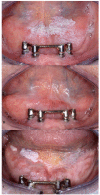Oral potentially malignant disorders: is malignant transformation predictable and preventable?
- PMID: 24905952
- PMCID: PMC4119315
- DOI: 10.4317/medoral.20205
Oral potentially malignant disorders: is malignant transformation predictable and preventable?
Abstract
Leukoplakia is the most common potentially malignant disorder of the oral mucosa. The prevalence is approximately 1% while the annual malignant transformation ranges from 2% to 3%. At present, there are no reliable clinicopathological or molecular predicting factors of malignant transformation that can be used in an individual patient and such event can not truly be prevented. Furthermore, follow-up programs are of questionable value in this respect. Cessation of smoking habits may result in regression or even disappearance of the leukoplakia and will diminish the risk of cancer development either at the site of the leukoplakia or elsewhere in the mouth or the upper aerodigestive tract. The debate on the allegedly potentially malignant character of oral lichen planus is going on already for several decades. At present, there is a tendency to accept its potentially malignant behaviour, the annual malignant transformation rate amounting less than 0.5%. As in leukoplakia, there are no reliable predicting factors of malignant transformation that can be used in an individual patient and such event can not truly be prevented either. Follow-up visits, e.g twice a year, may be of some value. It is probably beyond the scope of most dentists to manage patients with these lesions in their own office. Timely referral to a specialist seems most appropriate, indeed.
Conflict of interest statement
Figures



References
-
- Kramer IR, Lucas RB, Pindborg JJ, Sobin LH. Definition of leukoplakia and related lesions: an aid to studies on oral precancer. Oral Surg Oral Med Oral Pathol. 1978;46:518–39 PubMed PMID: 280847. - PubMed
-
- Warnakulasuriya S, Johnson NW, van der Waal I. Nomenclature and classification of potentially malignant disorders of the oral mucosa. J Oral Pathol Med. 2007;36:575–80. - PubMed
-
- Reichart PA, Philipsen HP. Oral erythroplakia. A review. Oral Oncol. 2005;41:551–61. - PubMed
-
- Holmstrup P, Vedtofte P, Reibel J, Stoltze K. Long-term treatment outcome of oral premalignant lesions. Oral Oncol. 2006;42:461–74. - PubMed
-
- Zhang L, Williams M, Poh CF, Laronde D, Epstein JB. Toluidine blue staining identifies high-risk primary oral premalignant lesion with poor outcome. Cancer Res. 2005;65:8017–21. - PubMed
Publication types
MeSH terms
LinkOut - more resources
Full Text Sources
Other Literature Sources
Medical
Research Materials

